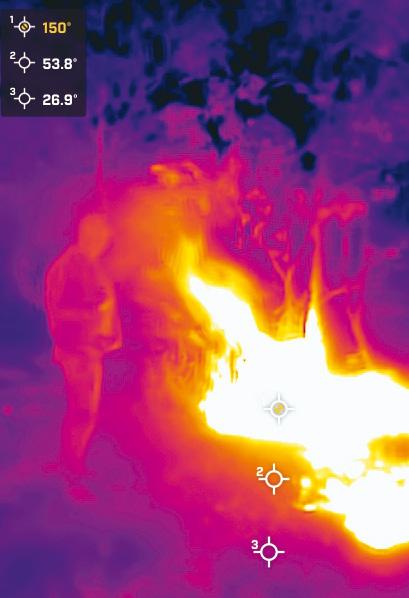
3 minute read
REKINDLING CULTURAL BURNING: THE NEXT CHAPTER AT MOUNT ANNAN
JOHN SIEMON, DIRECTOR OF HORTICULTURE AND LIVING COLLECTIONS, REPORTS ON RE-ESTABLISHING FIRST NATIONS CULTURAL BURNING AT MOUNT ANNAN.
On a chilly and dew-dampened midwinter morning, a significant milestone was achieved at the Australian Botanic Garden Mount Annan.
Advertisement
A cultural burn was undertaken; the first at the Garden since the dispossession of Aboriginal Peoples and the significant modification of the landscape, from native vegetation to agricultural pasture. This event marked a pivotal moment in the integration of Aboriginal cultural fire-management practices into modern land stewardship. The renewed interest in these traditional practices has surged, particularly in the aftermath of the devastating 2019–20 Black Summer fire season. This resurgence is not only transformative for Aboriginal communities, but it heralds a shift in how land managers handle fire and the environment, promising landscapes that will be more resilient to climate change and fostering healthy ecosystems. Cultural burning, or the right fire for the right Country, is a traditional practice where fire is used as a tool to manage the land, enhance biodiversity and maintain ecological balance. Aboriginal people have practised this for tens of thousands of years, understanding the intricacies of their environment, using fire to promote the health of the soil, plants, water systems and animals. This knowledge, passed down through generations, is deeply intertwined with cultural identity and responsibilities to the land, or Country.
The initiative at Mount Annan has been many years in the making, and it is through extensive consultation with the community that we have been able to make our critically endangered Cumberland Plain Woodland remnants available to help revive First Nations land management practices. Collaboration, trust and respect are fundamental to the success of this project and the Botanic Gardens of Sydney is committed to building strong, respectful relationships with the First Nations community.
Engaging the Aboriginal community is at the heart of this initiative. The project has been community-led, involving partnerships with local communities, the Rural Fire Service, government bodies and research institutions. Renowned Indigenous knowledge holder and cultural fire practitioner, Victor Steffensen from Firesticks, and Brad Moore of Greater Sydney Local Land Services, were instrumental in leading the training programs, sharing their expertise and rekindling traditional practices within the community. A particular thank you to Curator Manager, Michael Elgey, and Aboriginal Strategy & Development advisor, Brenden Broadbent, for their leadership and guidance and for completing the extensive pile of necessary, but challenging, paperwork and approvals.

Walking on Country, prior to the start of the cultural burn, there was a wonderful buzz and a genuine feeling of excitement. The cultural knowledge holders and fire practitioners gathered with their trainees and it was thoughtprovoking to observe and listen to the knowledge sharing and exchange.
Every facet of the cultural burn had a purpose, and each element was tailored to the vegetation community that was being burnt. In the minutes leading up to the cultural burn, several grass clumps were ignited, their dry discarded leaves swiftly combusting. The slow smouldering of the grass bases generated light smoke trails that wafted delicately downwind, signalling to wildlife of an approaching fire and calling out to them to move to safety.
As the cultural burn commenced, I commented to my colleagues how calm and serene the setting was. It presented such a contrast to historic hazard reduction or ecological burns at Mount Annan, where lines of fire fighters using drip torches, light strips of bushland typically in tinder-dry environments. By contrast the cultural burn is undertaken in the cooler months of the year when moisture content is high and only the combustible components ignite and then self-extinguish, taking with them fire-sensitive weedy species and preserving the fire-adapted native species. The outcome is a distinct mosaic of green and black – a signature of a culturally managed post-fire landscape. These green remnants quickly regenerate, providing grazing opportunities for larger wildlife and refuge for insects.
It was a truly empowering experience watching our staff join community to participate in the cultural experience.

Armed with ribbons of bark as ‘matches’, and small leafy eucalypt branches, which are used to dampen an overly enthusiastic patch of fire, the cultural burn participants randomly and methodically worked their way through the target woodland remnant, initiating a regenerative ecological process, rekindling the art of cultural burning and leading to a much richer tapestry of biodiversity in future years.
A key measure of success for me was watching the solitary Rural Fire Service vehicle redundantly sitting idle in the carpark. This level of trust in the process is one that, even just a few years ago, would not have existed.
The reintroduction of cultural burning is not only about managing fire; it’s about healing the land, preserving cultural heritage, and creating resilient ecosystems. Through this project, the Aboriginal community will regain and share their traditional knowledge, helping to transform modern land management practices. As these ancient techniques are woven into contemporary strategies, we move towards a future where our landscapes are healthier, our communities are more connected, and our relationship with the land is one of respect and sustainability. Through embracing traditional practices of Aboriginal Peoples we ensure that this knowledge continues to guide us in caring for Country for generations to come and forging reconciliation.










